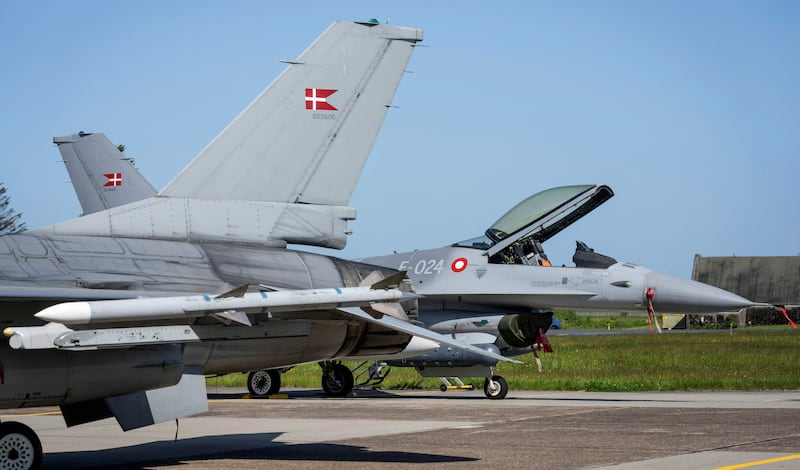As Ukrainian pilots prepare to train for the first time this month on US-built F-16 fighter jets, there are two big strategic aims at stake: transforming Ukraine’s old Soviet-style air force into a western one, and hauling its military more rapidly into line with Nato’s defensive capabilities.
Both of those aims are essentially about securing Ukraine’s future. Geopolitically, supplying enough F-16s for an effective small air force is a hugely expensive multi-year project demanding the type of EU and Nato collaboration that will illustrate to Vladimir Putin the resolve of Kyiv’s allies.
And tactically, having sent that message of unshakeable resolve, while the jets cannot hope to provide anything approaching air superiority for Ukraine, they have the potential to form the basis of a relatively up-to-date deterrent in a battlefield where every deterrent saves civilian lives.
That’s why, when the Biden White House relented in May and reversed an earlier decision not to sanction the use of F-16s by Ukraine, it said the reversal was based on the function of the aircraft in supporting “mid- and long-term defence needs” – in other words, the need to dovetail with Nato.
It’s important to realise though that F-16s are not “plug-and-play” technology of the type participants in 21st century conflict expect.
While they’ve been popular because they can fight both air-to-air and air-to-ground, they’ve been in service since 1979, have had multiple upgrades since then – and as a result often have differing software, radar and even electronic warfare standards from country to country.
[ ‘We’re not Amazon’: tensions with Ukraine surface at Nato summitOpens in new window ]
That’s the crux facing the Dutch, who’ve been chosen as the European training co-ordinators for the Ukrainian pilots, assisted by Denmark. Straight out of the starting blocks, the challenge is to source somewhere between 20 and 30 of these jets with – primarily – common software standards.
The Dutch and the Danes were chosen at the Nato summit in Vilnius last month because both countries are in the process of transitioning from the F-16 to the new generation Lockheed Martin F-35 – which fly out of Volkel airfield, a former Luftwaffe base in the south of the Netherlands.
While F-16s are referred to in terms of their technical kit as “fourth generation aircraft”, the F-35 is very much fifth generation – which typically means it has low-probability intercept radar (LPIC), stealth capability, agile airframe and advanced avionics, including weapons systems.
Volkel, in fact, is home to a squadron of each generation – 312 Squadron is an F-16 squadron, and 313 Squadron is an F-35 squadron. Many of the pilots have flown both, some on multiple missions in Afghanistan before the return to power there of the Taliban in 2021.
For those who remember the original Top Gun movie, Volkel is the more low-key Dutch equivalent of Marine Corps Air Station Miramar, near San Diego, California, nicknamed “Fightertown USA”.
As a result, the Dutch know F-16s intimately, still fly 24 of them, still train on them, and already have 18 retired and available for immediate transfer to Ukraine. Ukrainian president, Volodymyr Zelenskiy, has characteristically been more bullish, saying Kyiv would ultimately like to receive 40 to 50.
This is a long-term initiative... That’s why we need as many countries as possible joining forces to begin the task
— Denmark’s acting defence minister Troels Lund Poulsen
So how will the training progress?
In March, the first two Ukrainian pilots, highly experienced flying Soviet-era MiGs, began training in the US, having their capabilities assessed on simulators in Tucson, Arizona, to begin to generate some realistic indicators of the parameters of a wider training programme and the time required.
In June, Dutch defence minister, Kajsa Ollongren, in a written briefing to parliament, revealed that a new flight training centre would be established in an unnamed “Eastern Nato member country”, which has since transpired to be Romania.

The training will be in three stages: conversion training, language proficiency, and then initial flight training. Two groups of 12 Ukrainian pilots each would start the programme, to be combined with a €40 million air defence package for Ukraine announced by the defence contact group, Ollongren said.
“Flying-wise, if you’re an experienced fighter pilot, even the F-16 to some extent is just another airplane,” says Colonel Laurens-Jan Vijge, a Dutch F-35 pilot who flew F-16s for 15 years and who’s part of the team assembled to train the Ukrainians.
In a recent interview with Reuters, , he identified an essential difference between flying an F-16 and a MiG – what he calls “the hands-on throttle and stick”.
“On the F-16 you use the throttle to accelerate and the stick to control the plane. That means that on both the throttle and the stick there are lots of buttons you use to control the avionics. Usually in Soviet aircraft, that’s less part of the design or even non-existent.”
It’s worth remembering too that it’s not just about flying these highly responsive attack jets, capable of reaching a top speed of Mach 2 or 2,100kph.
Making the programme a success means training the Ukrainians to fly, service and maintain the jets, with adequate ammunition and spare parts and all the high-end technical expertise to keep the show on the road in moments of crisis.
In July, at a meeting between the defence ministers of Ukraine, the Netherlands and Denmark, Romania as the training location was finally out in the open and the timescale was gradually becoming clearer, as was the impressive number of countries committed to providing technical and support personnel – the UK, Canada, Poland, Norway, Sweden, Portugal, Belgium and Luxembourg.
Ukraine’s defence minister Oleksii Reznikov said the best advice by then was that the training modules would last no longer than six months.
Denmark’s acting defence minister, Troels Lund Poulsen, agreed and again emphasised the rolling nature of the collaboration: “Hopefully, we’ll see the results by the beginning of next year. This is a long-term initiative, however. That’s why we need as many countries as possible joining forces to begin the task.”
Even so, Brynn Tannehill, a senior technical analyst at US think tank Rand, has no illusions about the capacity of F-16s to turn the course of the war in Ukraine’s favour, although she does see how such capacity might support Kyiv’s campaign to win back the Crimean peninsula, annexed by Vladimir Putin in February 2014.
[ Ukrainian pilots to be trained to fly F-16s this summer, Nato announcesOpens in new window ]
As things stand, she says, even in the hands of US aviators, F-16s are no match for large Russian fighters such as the MiG-31 or the Su-35, both of which can “see” significantly further with their more powerful radar.
“In other words, Russian jets can potentially spot F-16s and shoot them down before the F-16s see them coming. That’s exactly what’s been happening with Ukraine’s current fleet of MiG-29s and Su-27s, and the improved capabilities of the F-16 are not enough to tilt this disparity in Ukraine’s favour. So it’s not a panacea.”

On the other hand, suggests Tannehill, if Ukraine’s F-16s were to be equipped with long-range Joint Air-to-Surface Stand-off Missiles (JASSM) they could be critical to Ukraine’s aim to retake Crimea “without a fight”, as Mr Reznikov suggested recently.
Achieving this would require the capacity to leave Russian troops on the peninsula exposed by cutting them off from their supply lines via the Kerch Strait bridge, via the land route from Rostov-on-Don – the largest city in southern Russia, just 100km from Ukraine’s border – or via Black Sea ports such as Sevastopol or Novorossijsk.
The tactical challenge is far more complicated than simply retraining a corps of experienced Ukrainian pilots and delivering a handful of well-used but reliable F-16s to them
Using JASSM, F-16s could give Ukraine the ability to consistently hit logistics hubs such as port facilities, ammunition depots, command-and-control facilities, and bridges such as Kerch – at 19km the longest and most complex bridge ever constructed by Russia – and by any standards a prestige target.
That’s why, while it undoubtedly came as a surprise that Ukraine used sea drones in two separate high-profile attacks on Russian ships in the Black Sea last weekend, it was little surprise that the targets were located where they were.
For Ukrainian tacticians, the name of the game in the Black Sea is disruption of Russian logistics.
In that context, it’s worth noting that JASSM could also serve as a stand-in for the ground-launched ATACMS (Army Tactical Missile System), a tactical ballistic missile with a range of about 300km which Ukraine has so far unsuccessfully requested from the US.
The bottom line then is that the tactical challenge is far more complicated than simply retraining a corps of experienced Ukrainian pilots and delivering a handful of well-used but reliable F-16s to them.
Every step closer that Ukraine can move to Nato capabilities is positive for the country in that – barring tumultuous change emanating from the White House – it commits both sides to future technological co-evolution and the cultural convergence that comes with it.
And while the doughty F-16 on its own may indeed not be a game-changer, military operations are sometimes described as coming together like “an orchestra of firepower”.
In such an orchestra, it could play a crucial role in augmenting future Ukrainian counteroffensives aimed at retaking occupied land and forcing Russia out of Crimea.
Ukraine’s race for F-16s
F-16s: fourth-generation US-built fighter jets, gradually being replaced by fifth-generation F-35s
30 to 40: Number of F-16s Volodymyr Zelenskiy says Ukraine needs asap
24: Number of F-16s in service and awaiting retirement in Netherlands
18: Number of “retired” Dutch F-16s ready for transfer to Ukraine
30: Number of F-16s in service and awaiting retirement in Denmark
13: Number of retired Danish F-16s ready for transfer















